Are you using the power of compound interest to your advantage?
Have you ever wondered how compound interest works? Or better yet, why compound interest can make you so INCREDIBLY RICH over time?
Albert Einstein has often been credited as famously stating “Compound interest is the eighth wonder of the world. He who understands it, earns it … he who doesn’t … pays it.”
Great quote! But it just barely begins to describe shear potential behind this wonderful financial phenomenon.
When used correctly, compounding interest is what can take your modest, periodic savings and turn it into thousands or even millions of dollars later on in your life.
And the best part is: You don’t have to be financial wizard to take advantage of it. Using compound interest to grow your fortune is one of the EASIEST money generating strategies that anyone can use. Literally ANYONE can put it work assuming there’s enough time and they’re earning a reasonable rate of interest.
That’s why I have dedicated this entire post to making sure you understand the power of compound interest, how it works, and why it can be so magical for you and your money over time. Keeping just a few key points in mind can mean the difference between retiring with a five, six, or seven figure net worth!
But before we get started, let’s clarify a few of the major terms that we’ll be using throughout this post.
The Difference Between Compound Interest and Compounding Returns
Often times when it comes to investing, you’ll hear the terms “compound interest” and “compounding returns” used interchangeably.
Even though the workings of both are similar, there are some subtle differences that you should first understand:
- Compound interest is the money you earn on an investment with a fixed or guaranteed rate of interest. Examples of this would be a bank savings account, money market account, or CD (certificate of deposit).
- Compound returns (or continuously compounded returns) is often used to describe an “average” rate of return on an investment where the earnings fluctuates over time and is NOT fixed or guaranteed. For example: Stocks rarely ever return the same earnings rate over time. Because the markets are free to fluctuate up and down, so does the value of your investment day to day. Because describing a range of values would be meaningless, we need a single number to talk about “how the fund has performed”. Therefore, we express performance of these assets in term of average rate of return just the same as if it was simple compound interest.
Terminology aside (and to keep this post simple), the application of “interest” and “annual returns” can be mathematically calculated the same way. And better yet, the key take-away’s for both terms is that they can make you very rich over time!
Great! So now that we’ve got the definitions out of the way, how does compound interest work exactly?
How Does Compound Interest Work?
What exactly does it mean to “compound” something?
Simply speaking, compounding is used to describe a situation where something grows and grows upon itself. Think about a cell in your body that splits from 1 into 2, and then 4, and so on.
Relating this back to money, “compound interest” is used to describe money (earnings) that grows on top of your investment (called the principal or contributions).
When this occurs, your earnings will grow on top of both the money you earned plus the money you contributed. With the balance of money growing higher each year, the amount of interest earned will also grow with each year, only adding to the balance even more.
Given enough time, the total amount of earnings will actually begin to exceed your initial contributions. In other words, you’ll be making more money from the accumulation of your earnings than you will from the money you saved.
Don’t believe me? Let’s check out a few examples to see the magic of compound interest at work!
Compound Interest Example with a One-Time Investment
Let’s say you have $10,000 that you’d like to invest.
You shop around, and you find an investment that promises a rate of return of 10% per year.
Here’s how the power of compound interest would work it’s magic:
Year 1:
- Starting balance (initial investment): $10,000
- Interest earned: $10,000 x 10% = $1,000
- Total ending balance: $10,000 + $1,000 = $11,000
Year 2:
- Starting balance: $11,000
- Interest earned: $11,000 x 10% = $1,100
- Total ending balance: $11,000 + $1,100 = $12,100
Year 3:
- Starting balance: $12,100
- Interest earned: $12,100 x 10% = $1,210
- Total ending balance: $12,100 + $1,210 = $13,310
… and the pattern would continue …
Continue to keep this investment, and by the end of Year 8, your balance would be $21,436. That’s more than double the $10,000 you initially started with.
By the end of 30 years, your initial investment of $10,000 would be worth a grand total of $174,494! That’s over 17 times your initial investment.
Here’s what it would look like:
Side note: Try your own calculations for free! All of these figures and graphs were created by using the free Compound Interest Calculator found on Investor.gov. Feel free to give it a try and see how your money could look over time.
Okay, so now you get the general idea of how compound interest works.
But let’s take it a step further to really see it in action.
Compound Interest Example with Annual Contributions
A one-time, up-front investment is nice. And we used this example as a simple demonstration for how compound interest works.
But let’s be real … most of us don’t save our money in this way.
In reality, we add to our finances periodically, saving a little bit more every time we get paid (such as when we put money into our 401(k) or IRA to save for retirement).
When we make these periodic deposits, these are called contributions. And they are what can take compound interest to the next level!
Let’s redo the example above where you find an investment that pays 10% interest each year. But this time, instead of starting off with $10,000, we’ll assume we start with a balance of $0. At the same time, we’ll also assume that you are putting away $1,000 each month (or $12,000 per year) as we roll along.
Here’s how that would work out:
Year 1:
- Starting balance (initial investment): $0
- Interest earned: $0 x 10% = $0
- Annual contribution: $12,000
- Total ending balance: $0 + $0 + $12,000 = $12,000
Year 2:
- Starting balance: $12,000
- Interest earned: $12,000 x 10% = $1,200
- Annual contribution: $12,000
- Total ending balance: $12,000 + $1,200 + $12,000 = $25,200
Year 3:
- Starting balance: $25,200
- Interest earned: $25,200 x 10% = $2,520
- Annual contribution: $12,000
- Total ending balance: $25,200 + $2,520 + $12,000 = $39,720
… and, again, the pattern would continue …
Keep going with this investment, and by the end of 30 years, your annual contributions would have grown to a value of $1,973,928! That’s 5.5 times more than your total contributions!
Notice anything surprising happening in the graph?
In the beginning, the earnings (red line minus blue line) don’t really seem to add much your overall ending balance. But then around Year 15, something amazing happens. Your earnings actually start to out-weight your contributions (by this point, $201,270 vs $180,000). Again, you are now making more money off of the interest than you are on your own contributions. This becomes more and more evident as the years go on by noticing how the red line out-paces the blue line.
How incredible is that? Your savings has basically now become a money-generating machine that will continue to produce more and more earnings for as long as you keep the investment going. How cool is that?
How Compound Interest Helps You Retire
As you can probably tell from the second example, compound interest is an incredibly useful tool that regular people can use to grow their wealth beyond anything that they could ever save on their own.
Just compare the second example to another scenario where the person put the money into their “regular bank, no interest” savings account instead of one that gains interest. By the end of 30 years, they would have only stashed $12,000 x 30 = $360,000 into their savings account. Not too shabby, but that’s a LONG, LONG ways away from the previous example where we ended with a balance of $1,973,928.
What does that mean in terms of your retirement?
Using the 4 Percent Rule as a general estimate for how much money you’d be able to enjoy each year given our two scenarios, that’s a difference of:
- Nest egg with no compound interest: $360,000 x 0.04 = $14,400 per year in retirement
- Nest egg with compound interest: $1,973,928 x 0.04 = $78,957 per year in retirement
I think the choice is clear! You want to grow your nest egg as much as possible using compound interest.
This is exactly why it’s important to make sure that when you’re saving for retirement (or any long-term goal), you give yourself the maximum advantage you can by putting your money into reliable investments with a reasonable rate of return.
So where can we go to do this?
Where to Invest for Compound Interest and Compounding Returns
Believe it or not, the example I gave earlier is not too far off from reality.
Not so fast … Unfortunately there aren’t any banks or financial institutions offering savings accounts or CD’s that pay a guaranteed rate of 10% per year. (Although in the 1990’s, I do recall investing in CD’s that were in the 6-8% range. And yes, I was a financial nerd even back then.)
These days, it’s pretty easy to hit up a site like BankRate and find reputable CD’s in the range of 2.0% or more.
Guaranteed return rates are nice. But if you really want compound interest to take your money to the next level, you’re going to need to find investments with a higher rate of return. And in order to shoot for a better rate, you’re going to have to accept some risk. This will mean investing in assets such as stocks and bonds.
Remember! The rate of return on stocks and bonds fluctuate over time. Even though they tend to increase in value over time, please understand that in the short-term they can lose money. Again, this get’s back to the fundamental difference between compound interest and compounding returns.
Now, don’t worry. I’m not going to suggest that you go out picking individual stocks like you’re the next Warren Buffett. Nor will I recommend that you try to identify which companies or governments have bonds worth purchasing.
There’s a more efficient way to manage this: By purchasing mutual funds or ETF’s where you can invest in dozens or even hundreds of stocks and bonds all at once. (And it’s no coincidence that this is why most retirement plans typically offer only these products.)
In fact, you really only need to look no further than at index fund if you’d really like to keep things simple.
What’s an index fund?
An index fund is a benchmark that is used for comparison against other similar investments. In terms of stocks, the most widely followed ones are the S&P 500 or the Dow Jones Industrial Average.
Think about when you watch or read the news. When they say “the market was up” or “the market was down”, they are generally referring to one of these index funds rather than on any specific investment.
There is an extremely popular belief (backed by many famous investors and academics) that if the common person simply invests in an index fund that they can capture the “average” return of the market. And by doing so, they can beat 90% of the other investment products available!
What kind of return rate can you expect with an index fund?
Finding the rate of return on any index fund is only a Google search away.
For example, you can see the annual compound return rate over many different time periods for the S&P 500 by checking out Wikipedia.
If you go to the bottom and scan across the bottom figures, you can quickly recognize that in the short term, the return rate can fluctuate pretty wildly (+38% to -37%) from year to year. But when you average the returns over 15 years or more, the fluctuation reduces to a range between 19% to 4%.
In other words, when you invest for the long haul, compounding returns have a better chance of returning a higher, positive rate!
Find out more about how to easily buy a stock market index fund.
Two Important Ways Compounding Returns Can Make You Rich
As you may have noticed with the examples we’ve shown so far, there are two very important strategies you can use to your advantage to create the biggest fortune possible.
They are:
- Start saving as early as possible
- Save as much money as possible early on
Strategy No. 1 – Start Saving As Early As Possible
One of the things that most people don’t realize until years of saving when their fortunes are bigger is just how BIG of a difference a year can make.
Makes sense. Consider the two perspectives:
- Saver just starting out with $10,000 in savings. 10% return will yield $1,000.
- Saver 30 years into their career with $2,000,000 in savings. 10% return will yield $200,000!
As you can see, the more money we have, the higher the payoff potential from our compounding returns.
So with that in mind, let’s go back to our second example (investing $12,000 per year for 30 years with a 10% return rate) and see what would happen if we held out for one more year. By year 31, our hypothetical balance would grow to $2,183,321.
That’s not to be taken lightly! Revisiting the 4 Percent Rule again, this change of $209,392 means you could theoretically enjoy $87,333 per year in retirement instead of $78,957. That’s $8,376 more for you to do as you wish!
But do you really want to add 1, 5, or even 10 more years onto your savings horizon in order to be able to build a fortune such as this? If you’re like me, then you’d probably hope to enjoy your money as soon as possible.
So how else can we take advantage of this phenomenon?
Simple … start saving NOW! Not tomorrow, NOT next week, NOT one year from now …. NOW!
Strategy No. 2 – Save As Much Money As Possible Early On
One of the most typical mistakes people make early on their careers is to contribute far too little to their retirement accounts.
Why do they do this? Ask 100 people and you will get 100 different excuses.
- “I’m saving for something else”
- “I don’t have any extra money to spare”
- “Retirement is so far away, who cares!” ….
Yet mathematically, they are not taking complete advantage over a tremendous opportunity before them.
Let’s again revisit someone who is just starting to save early on their career:
- Saver just starting out with $1,000 in savings. 10% return will yield $100.
- Saver just starting out with $10,000 in savings. 10% return will yield $1,000.
Obviously the saver who puts more away will not only yield more earnings, but their money will accumulate much, much faster than someone who takes their time to ramp up their savings rate.
But wait? Why can’t I just save more later on in life and catch up later?
Let’s look at an example of the difference between starting at age 25 versus age 35. Assuming you put away $5,000 each year, got an 8% return, and planed to retire at age 65, how much different would your potential return be?
Ouch!! The “starting at age 35 portfolio” would be just under half of the of the “starting at age 25 portfolio”.
You might say, “But I can’t afford to put money away now! I’ll start later on when I make more money and put more in to catch-up.” Okay, let’s run that example too. We’ll compare starting at age 25 by putting away $5,000 per year versus starting at age 35 and putting away $10,000 each year (and all the other variables are the same). Now who comes out ahead?
Ouch again! The “starting at age 25 portfolio” still comes out on top. And even though they are close, which would you rather have: $5,000 taken out of your check each year or $10,000 taken out of your check each year? I know which one I’d prefer!
Bottom line: The more you save now, the more time you give your investments to mature and grow. Ultimately, you’ll be putting yourself in the best possible position you can to build your fortune and achieve financial freedom!
My Advice – Max Out Your Savings TODAY!
So now that you know saving early and saving more are the two main ingredients to leveraging the power of compound interest, there’s one thing I want you to do: Go increase your retirement savings contributions today!
Seriously! If there’s one thing I hear people ask over and over again, it’s “how much should I be contributing to my 401(k)?” After seeing these benefits, the answer should be clear: As much as you possibly can! Contribute all the way up to the 401(k) maximum limit of $19,000 per year! Double that if both you and your spouse work!
Why your 401(k)? Because when it comes to places to save and grow your money, with tax-advantaged retirement accounts, you’re effectively saving more money than you would with a regular bank account with each dollar you contribute. You can read more about this in this article here.
Do you have an IRA? You can maximize that one too. In fact, maximize each of your “retirement buckets” and other savings vehicles as much and as soon as you possibly can.
Okay … so maybe you can’t start stashing away an extra $19,000. That’s fine, but don’t give up. Work towards this goal!
How? By designing a budget for your household that works. Here’s a few tips to get you started:
- The 10 Best Practical Ways to Budget Your Money and Save More
- Monthly Budget Not Working? Why An Annual Budget Is Better
- 1000 Ways to Save More Money!
Remember that the key to budgeting is not to restrict your spending, but rather to create a plan for how to BEST spend your money.
Summary
Compound interest and compounding returns are an incredible phenomenon that can allow your savings to grow to levels beyond anything you could ever acquire on your own. But in order to put that power to work for you, you have to keep two things in mind: 1) Start saving as early as possible and 2) save as much as you can, especially early on. Tax-advantaged retirement plans like your 401(k) or IRA are a great place to start doing this not just because of the compounding benefits, but also because of the tax savings.
Remember: There’s no time to waste! Start putting your plan together for how you can set more money aside each month. In the years to come, you’ll increase your potential to be richer. Your future self will thank you!
Readers – How do you use the power of compound interest and compounding returns to your advantage? What success have you experienced in using it to grow your savings?
Image credits: Pixabay, Unsplash, Investor.gov

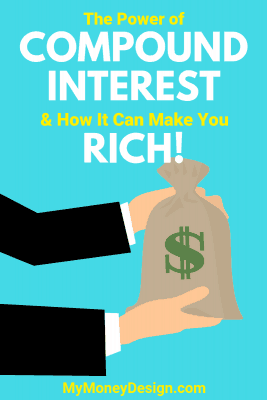

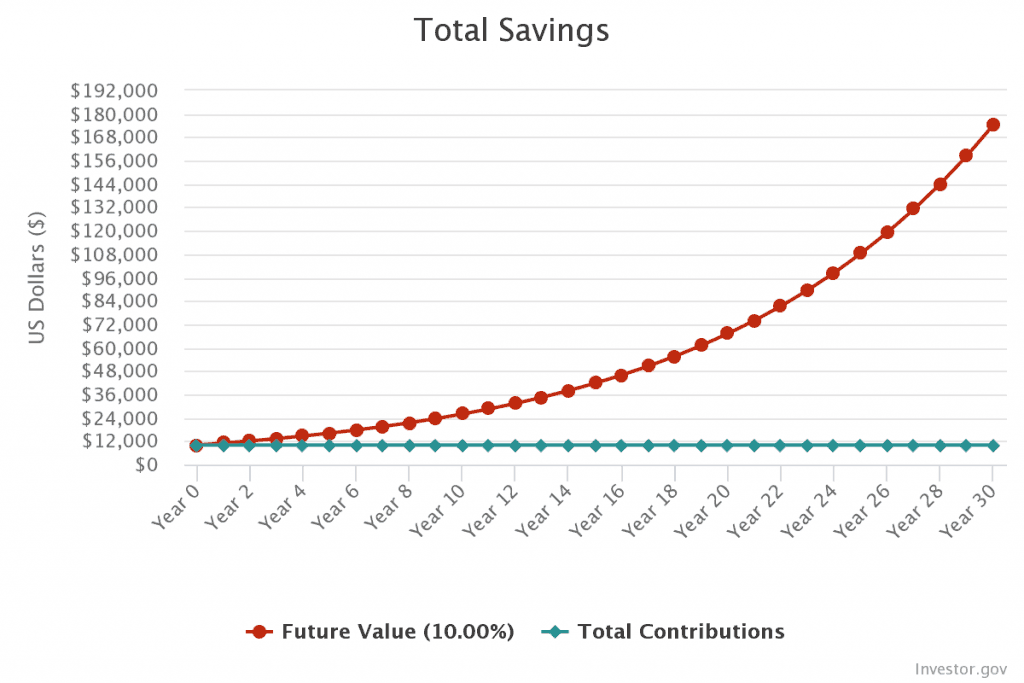
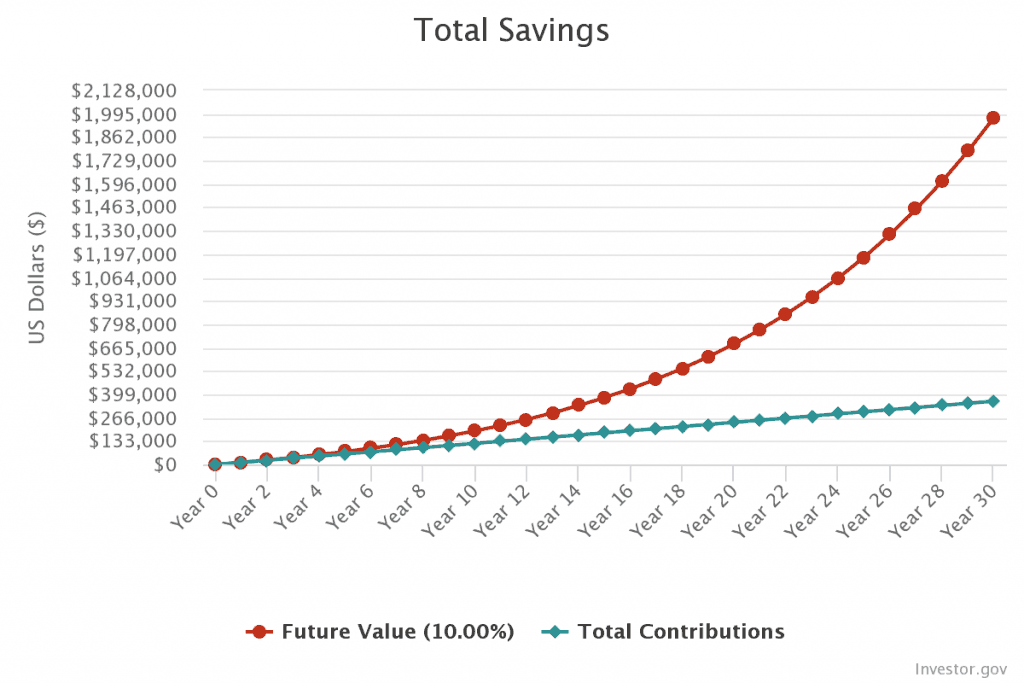


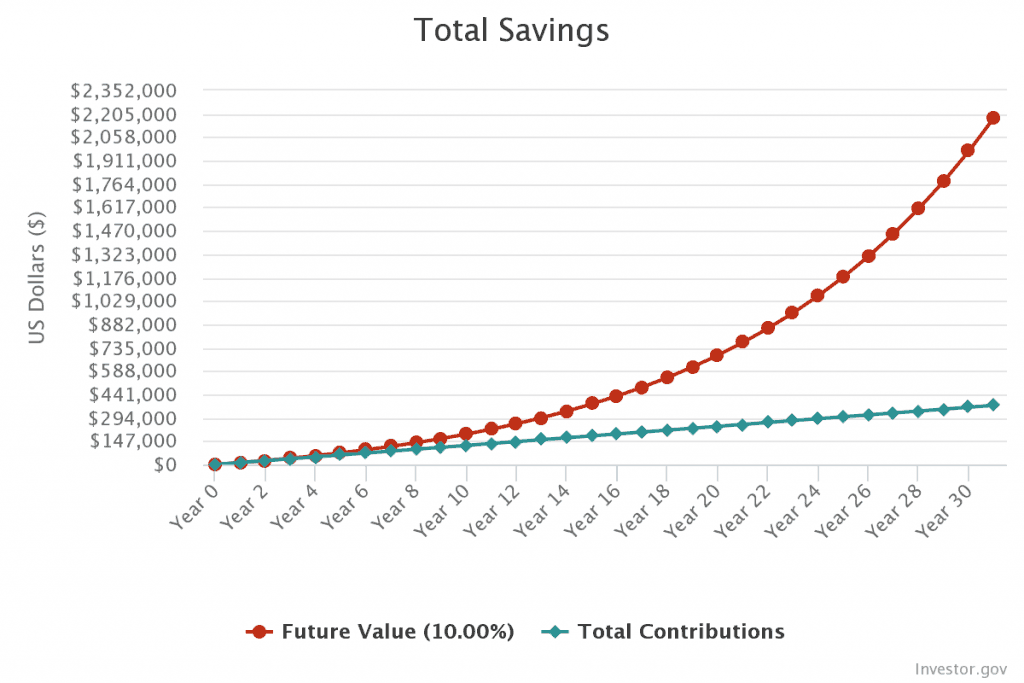
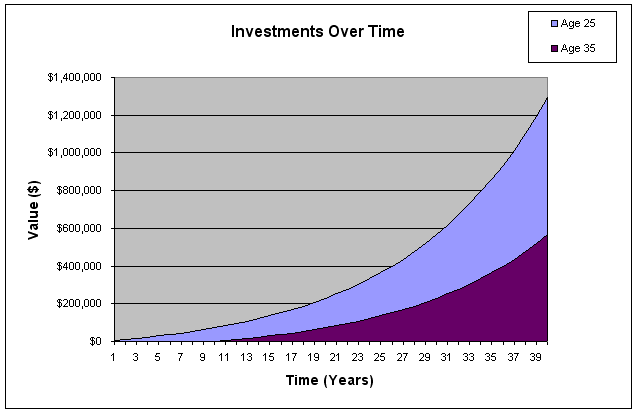
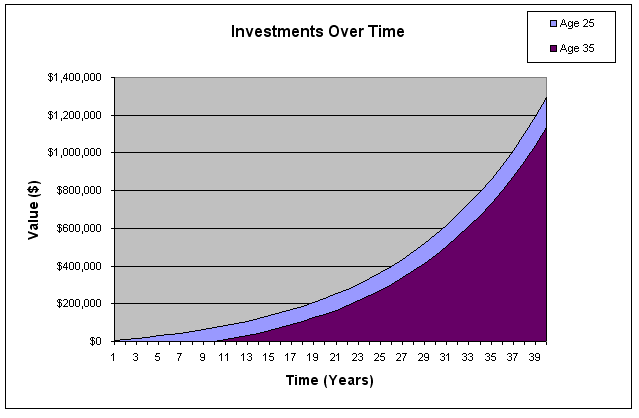

I watched my 401k grow to over a million just like in your examples. The first 15 years or so it looked like a turtle, slow moving, but it really took off after that! It takes patience but the math works.
I started investing 3 months ago. I put 6k into my ira and have about 6k in my 401k. Started to contribute 13% per check and have about 40k in my brokerage.
Trying to decide if the traditional 401k vs ira is best since i already have an IRA outside of the work offered one.
I plan to contribute 40-60k a year until, well I haven’t decided. Ive realized that i don’t need money luke i thought I did. I need long term growth and am adopting the buy amd hold startegy. Hopefully I have a chance to make up for the losses endured throughout struggling in my 20s. I’m starting to get a little worreid that i am not taking full adavntage of the tax situation. It’s a lot to wrap my head around, but i think I am starting down the right track, kind of.
Any advice?